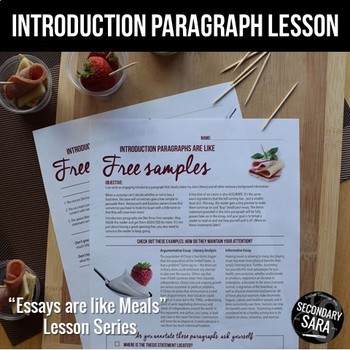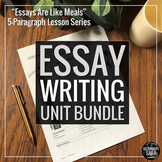Introductions are like Free Samples (DISTANCE LEARNING): Lesson for ANY Essay!
- Zip
- Google Apps™

Also included in
- Now with Google Slides versions of lessons for distance learning! Students need to learn the rules in order to break them. Teach students about five paragraph essay structure with this bundle of lessons, ready to use before or during ANY essay assignment (or before standardized testing!).Each lessonPrice $24.99Original Price $27.49Save $2.50
- My students spend a lot of time mastering the foundations of essay writing so they are well-prepared for upper grade levels, standardized tests, and college. Download ALL of my best essay-writing lessons and save yourself TONS of time with classroom-tested resources! This bundle includes ALL of myPrice $49.99Original Price $67.84Save $17.85
Description
Now includes Google, PDF, *and* Office versions! Introduction paragraphs are like free samples of food – it’s your one chance to grab a customer (reader) and convince them to “buy in” and keep reading.
This lesson teaches students that it’s important to not just have a great hook, but make the entire paragraph clear and compelling so that readers get an accurate, engaging preview of what will be discussed.
This lesson (PDF, Google Slides, and editable PPT files), applicable for argumentative OR informative essays, was designed as an introduction (ha!) for students who have not been taught this content before, BUT it also serves as a great review lesson for older students, or for any learner who just needs to hear something multiple times.
This lesson includes an introduction, two mentor text paragraphs, a “recipe” checklist for good introductions, some words of caution, and then an immediate formative assessment opportunity.
Use this lesson to collect formative data in two ways. First, students attempt to write their own introductions for you to assess; then, an exit ticket asks students to summarize what they have learned to see what stuck out to them and whether or not they “got it”.
NOTE: This product is INCLUDED in my Five Paragraph Essay BUNDLE and is also featured in my Essay Mega Bundle! Check them out to save big!
Check out the other lessons in the series!
• FREE: Conclusions are like Dessert
• Thesis Statements are like Menus
• Body Paragraphs are like Courses
• Transitions are like Waiters
• Proofreading is like Checking your Teeth
****************************************
You might also like…
My other writing materials:
• "Short Research Projects" original Volume I Bundle
• "Short Research Projects" Volume II Bundle
• "Why Grammar?" essay project
****************************************
Connect with Me




